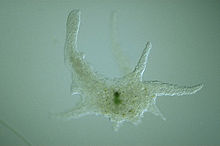- Chaos (genus)
-
Chaos 
Chaos carolinensis Scientific classification Domain: Eukarya Kingdom: Amoebozoa Phylum: Sarcodinal Class: Tubulinea Order: Tubulinida Family: Amoebidae Genus: Chaos
Linnaeus, 1767 [1][2]Species - Chaos carolinensis
- Chaos chaos
- Chaos illinoisense
Chaos is a genus of giant amoebae, varying from 1–5 mm in length. They are closely related to Amoeba, and share the same general morphology, producing numerous cylindrical pseudopods. However, Chaos have several hundred nuclei, while Amoeba only have one. The most notable species is C. carolinensis; they have also been classified as Pelomyxa, another giant multinucleate amoeba, but they are not particularly similar.
Chaos feed on bacteria, fungi, other protists and multicellular rotifers. They are heterotrophs like all members of sarcodina, and obtain food energy by ingestion. They are mostly scavengers and are found on the bottom of freshwater habitats.
Chaos move by pseudopodia. They do not have a hard cell wall. The cytoplasm is divided into: the fluid endoplasm that contains the many nuclei, granules, and food vacuoles; and the more viscous ectoplasm that does not contain any granules.
An interesting aspect of Chaos, from a histological perspective, is the number of mitochondria it contains. The mitochondrion is an organelle best known as the powerhouse of the cell for its role in providing the cell and host organism with its energy needs, but the organelle is responsible for a range of other biochemical roles. Most cells have on average hundreds to thousands of mitochondria, whereas it has been found that Chaos can contain upwards of 500,000 mitochondria.
Lobosea VannellidaCochliopodiidae (Cochliopodium)discosean: Dermamoeba
other: Sappinia, ThecamoebaArcellinidaEuamoebidaEchinamoebidae (Echinamoeba, Filamoeba, Gephyramoeba, Hartmannella vermiformis)
Leptomyxida (Leptomyxa, Rhizamoeba, Flabellula, Paraflabellula)
Copromyxidae (Copromyxa, Copromyxella)
Tubulinida: Amoebidae (Amoeba, Chaos, Hydramoeba, Metachaos, Polychaos, Trichamoeba) · Hartmannellidae (Glaeseria, true Hartmannella, Nolandella, Saccamoeba)CentramoebidaConosa Mastigamoebida: Mastigamoeba · Mastigella · Phreatamoeba · non-ciliate (Endolimax, Endamoeba)
Pelobiontida: Pelomyxidae (Pelomyxa) · Entamoebidae/non-cilitate (Entamoeba) · MastiginaMacromycetozoaDictyostelid: Dictyostelium · Polysphondylium · Acytostelium
Myxogastria: Liceida (Cribraria, Lycogala, Tubifera) · Myxogastromycetidae (Echinostelium, Fuligo, Lepidoderma, Physarum) · Stemonitida (Comatricha, Stemonitis) · Trichiida (Arcyria, Trichia)
other: CeratiomyxaProtostelialesPlanoprotostelium · ProtosteliumOtherPhalansterium · MulticiliaBreviatea BreviataOther/ungrouped Stereomyxa · TrichosphaeriumReferences
- ^ "Chaos Linnaeus, 1767". Nomenclator Zoologicus. http://www.ubio.org/NZ/detail.php?d=1&uid=37864. Retrieved January 11, 2011.
- ^ "Chaos Linnaeus, 1767". Biolib.cz. http://www.biolib.cz/en/taxon/id166441/. Retrieved January 11, 2011.
Bibliography
- Scheffler, Immo E. (2008). Mitochondria, 2nd ed., Wiley-Liss, 2007, ISBN 0470040734.

This protist-related article is a stub. You can help Wikipedia by expanding it.
